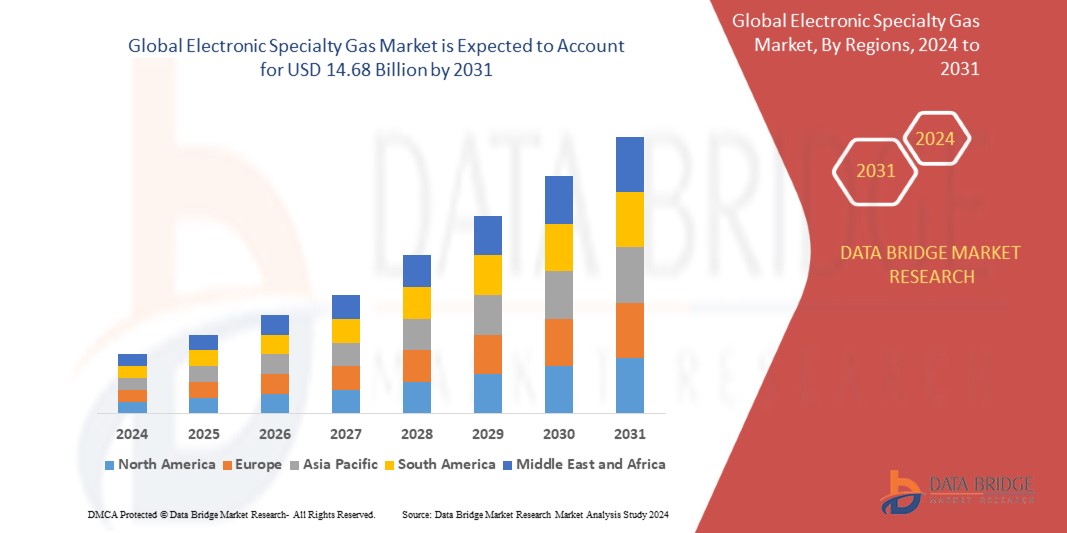Global Electronic Specialty Gas Market, By Type (Inert Gases, Silane and Silicon Gases, Halogen gases, Ammonia, Carbon gases, Hydrogen Sulfide and Others), Application (Semiconductors and Microelectronics, Flat Panel Displays, Photovoltaic Cells, LEDs), End-Use Industry (Electronics, Energy, Healthcare and Industrial) - Industry Trends and Forecast to 2031.
Electronic Specialty Gas Market Analysis and Size
The relentless growth in consumer electronics, coupled with advancements in semiconductor technology (such as smaller, more efficient chips for smartphones, computers, and IoT devices), fuels the demand for electronic specialty gases for manufacturing processes is expected to fuel the growth of the global electronic specialty gas market.
Data Bridge Market Research analyses that the global electronic specialty gas market was valued at USD 6.1 billion in 2023 is expected to reach the value of USD 14.68 billion by 2031, at a CAGR of 11.6% during the forecast period of 2024 to 2031. In addition to the insights on market scenarios such as market value, growth rate, segmentation, geographical coverage, and major players, the market reports curated by the Data Bridge Market Research also include in-depth expert analysis, geographically represented company-wise production and capacity, network layouts of distributors and partners, detailed and updated price trend analysis and deficit analysis of supply chain and demand.
Report Scope and Market Segmentation
|
Report Metric |
Details |
|
Forecast Period |
2024 to 2031 |
|
Base Year |
2023 |
|
Historic Years |
2022 (Customizable to 2016-2021) |
|
Quantitative Units |
Revenue in USD Billion, Volumes in Units, Pricing in USD |
|
Segments Covered |
Type (Inert Gases, Silane and Silicon Gases, Halogen gases, Ammonia, Carbon gases, Hydrogen Sulfide and Others), Application (Semiconductors and Microelectronics, Flat Panel Displays, Photovoltaic Cells, LEDs), End-Use Industry (Electronics, Energy, Healthcare and Industrial) |
|
Countries Covered |
U.S., Canada, Mexico, Germany, Sweden, Poland, Denmark, Italy, U.K., France, Spain, Netherland, Belgium, Switzerland, Turkey, Russia, Rest of Europe, Japan, China, India, South Korea, New Zealand, Vietnam, Australia, Singapore, Malaysia, Thailand, Indonesia, Philippines, Rest of Asia-Pacific, Brazil, Argentina, Rest of South America, UAE, Saudi Arabia, Oman, Qatar, Kuwait, South Africa, Rest of Middle East and Africa |
|
Market Players Covered |
Linde plc (Ireland), Air Products and Chemicals, Inc. (U.S.), Air Liquide ( France), Messer Group (Germany), Sumitomo Seika Chemicals Company, Limited (Japan), The Chemours Company (U.S.), Electronic Fluorocarbons, LLC (U.S.), Matheson Tri-Gas, Inc. (U.S.), SHOWA DENKO K.K. (Japan) among others |
|
Market Opportunities |
|
Market Definition
Electronic specialty gases refer to highly purified gases used in various stages of semiconductor and electronics manufacturing processes. These gases are crucial for creating controlled atmospheres, depositing thin films, etching surfaces, and enhancing material properties during the production of integrated circuits, LEDs, solar cells, and other electronic components. Electronic specialty gases are characterized by their exceptional purity levels, precise chemical compositions, and low levels of impurities. They are essential for optimizing performance, ensuring reliability, and achieving high yields in semiconductor fabrication, where even minute variations in gas composition can significantly impact device performance and quality
Electronic Specialty Gas Market Dynamics
Driver
- Growth in Semiconductor Industry
The growth of the semiconductor industry is propelled by increasing demands for advanced electronic devices across various sectors such as smartphones, computers, automotive electronics, and IoT devices. This expansion relies heavily on sophisticated semiconductor fabrication techniques such as chemical vapor deposition (CVD) and etching. Electronic specialty gases play a crucial role in these processes, providing essential elements and compounds needed for precise material deposition and etching patterns. The high purity and controlled composition of these gases are vital for ensuring the quality and performance of semiconductor components, supporting the industry's rapid evolution and innovation in electronic technologies.
- Increasing Demand for Photovoltaic (PV) Cells
The increasing demand for photovoltaic (PV) cells, driven by the global shift towards renewable energy sources such as solar power, is fueling market growth. Specialty gases play a critical role in the manufacturing process of these cells. For instance, gases such as silane (SiH4) and dopant gases such as phosphine (PH3) are used in the deposition and doping processes necessary for producing efficient solar cells. These specialty gases ensure precise control over material properties and enable the creation of high-performance PV cells. As the renewable energy sector expands, the demand for specialty gases in PV cell production is expected to continue rising.
Opportunities
- Innovation and Product Development
Technological advancements in electronics, such as smaller and more powerful components, OLED displays, and microprocessors, demand precise manufacturing processes. Electronic specialty gases, such as silane, ammonia, and nitrogen, are essential for semiconductor fabrication, OLED production, and microprocessor manufacturing. These gases enable processes such as chemical vapor deposition (CVD) for thin film deposition, plasma etching for circuit patterning, and organic layer deposition for OLED displays. High purity and precise composition of these gases ensure quality and performance in advanced electronic devices, driving the continual need for electronic specialty gases in the evolving electronics industry.
- Increasing Investments in Research and Development
Continual investments in R&D within the electronics and semiconductor industries propel exploration into novel materials and manufacturing methods, necessitating the development and application of new electronic specialty gases. Advanced processes such as atomic layer deposition (ALD) and extreme ultraviolet (EUV) lithography demand precise gas compositions and purities for optimal performance. As researchers discover innovative materials and techniques to enhance device performance and efficiency, the demand for tailored electronic specialty gases rises. This symbiotic relationship between R&D investments and gas innovation fuels market expansion, enabling the realization of cutting-edge electronic technologies
Restraints/Challenges
- High Cost of Specialty Gases
The high cost of electronic specialty gases is primarily attributed to the rigorous purification and handling processes required to achieve the exceptionally high purity levels essential for semiconductor and electronics manufacturing. Specialty gas production involves complex refining techniques, such as cryogenic distillation, chemical reactions, and filtration, to remove impurities down to parts per billion (ppb) or even parts per trillion (ppt) levels. Additionally, stringent quality control measures, specialized equipment, and stringent compliance with industry standards further contribute to the elevated production costs. These factors collectively make electronic specialty gases more expensive compared to standard industrial gases, reflecting the critical role they play in ensuring optimal performance and reliability of electronic device
- Stringent Regulatory Requirements
Stringent regulatory requirements in the electronics industry encompass environmental, health, and safety standards, imposing comprehensive guidelines on gas handling, emissions control, and disposal practices. Compliance with these regulations necessitates investments in specialized infrastructure, monitoring systems, and employee training to ensure safe handling and minimize environmental impact. Manufacturers must adhere to strict emission limits, implement efficient waste management protocols, and conduct regular audits to maintain compliance. Meeting these regulatory obligations adds complexity and cost to electronic specialty gas manufacturing.
This market report provides details of new recent developments, trade regulations, import-export analysis, production analysis, value chain optimization, market share, impact of domestic and localized market players, analyses opportunities in terms of emerging revenue pockets, changes in market regulations, strategic market growth analysis, market size, category market growths, application niches and dominance, product approvals, product launches, geographic expansions, technological innovations in the market. To gain more info on the Market contact Data Bridge Market Research for an Analyst Brief, our team will help you take an informed market decision to achieve market growth.
Recent Development
- Linde PLC offers a global network of production plants strategically located in core manufacturing hubs to bring the full range of special gases supporting all electronics manufacturing processes across the globe
Electronic Specialty Gas Market Scope
The market is segmented into type, application, and end-use industry. The growth amongst these segments will help you analyze meagre growth segments in the industries and provide the users with a valuable market overview and market insights to help them make strategic decisions for identifying core market applications.
Type
- Inert Gases
- Silane and Silicon Gases
- Halogen Gases
- Ammonia
- Carbon Gases
- Hydrogen Sulfide
- Others
Application
- Semiconductors and Microelectronics
- Flat Panel Displays
- Photovoltaic cells
- LEDs
End-Use Industry
- Electronics, Energy
- Healthcare
- Industrial
Electronic Specialty Gas Market Regional Analysis/Insights
The market is analyzed and market size insights and trends are provided by type, application, and end-use industry as referenced above.
The countries covered in the market report are U.S., Canada, Mexico, Germany, Sweden, Poland, Denmark, Italy, U.K., France, Spain, Netherland, Belgium, Switzerland, Turkey, Russia, Rest of Europe, Japan, China, India, South Korea, New Zealand, Vietnam, Australia, Singapore, Malaysia, Thailand, Indonesia, Philippines, Rest of Asia-Pacific, Brazil, Argentina, Rest of South America, UAE, Saudi Arabia, Oman, Qatar, Kuwait, South Africa, and Rest of Middle East and Africa.
Asia-Pacific is the most dominating region in global electronic specialty gas market, holding the highest share due to rapid expansion of the semiconductor industry, driven by demand for advanced electronics in smartphones, computers, automotive electronics, and IoT devices, is a primary driver. Electronic specialty gases are essential for semiconductor fabrication processes such as chemical vapor deposition (CVD) and etching.
China dominates in the global electronic specialty gas market as innovations in display technologies such as OLED and micro-LED screens in smartphones, TVs, and other devices require electronic specialty gases for fabrication processes, further boosting market demand.
The country section of the report also provides individual market impacting factors and changes in market regulation that impact the current and future trends of the market. Data points such as down-stream and upstream value chain analysis, technical trends and porter's five forces analysis, case studies are some of the pointers used to forecast the market scenario for individual countries. Also, the presence and availability of global brands and their challenges faced due to large or scarce competition from local and domestic brands, impact of domestic tariffs and trade routes are considered while providing forecast analysis of the country data.
Competitive Landscape and Electronic Specialty Gas Market Share Analysis
The market competitive landscape provides details by competitor. Details included are company overview, company financials, revenue generated, market potential, investment in research and development, new market initiatives, global presence, production sites and facilities, production capacities, company strengths and weaknesses, product launch, product width and breadth, application dominance. The above data points provided are only related to the companies' focus related to market.
Some of the major players operating in the market are:
- Linde plc (Ireland)
- Air Products and Chemicals, Inc. (U.S.)
- Air Liquide ( France)
- Messer Group (Germany)
- Sumitomo Seika Chemicals Company, Limited (Japan)
- The Chemours Company (U.S.)
- Electronic Fluorocarbons, LLC (U.S.)
- Matheson Tri-Gas, Inc. (U.S.)
- SHOWA DENKO K.K. (Japan)
SKU-





 Forecast Period
Forecast Period  Market Size (Base Year)
Market Size (Base Year)  Market Size (Forecast Year)
Market Size (Forecast Year) CAGR
CAGR













